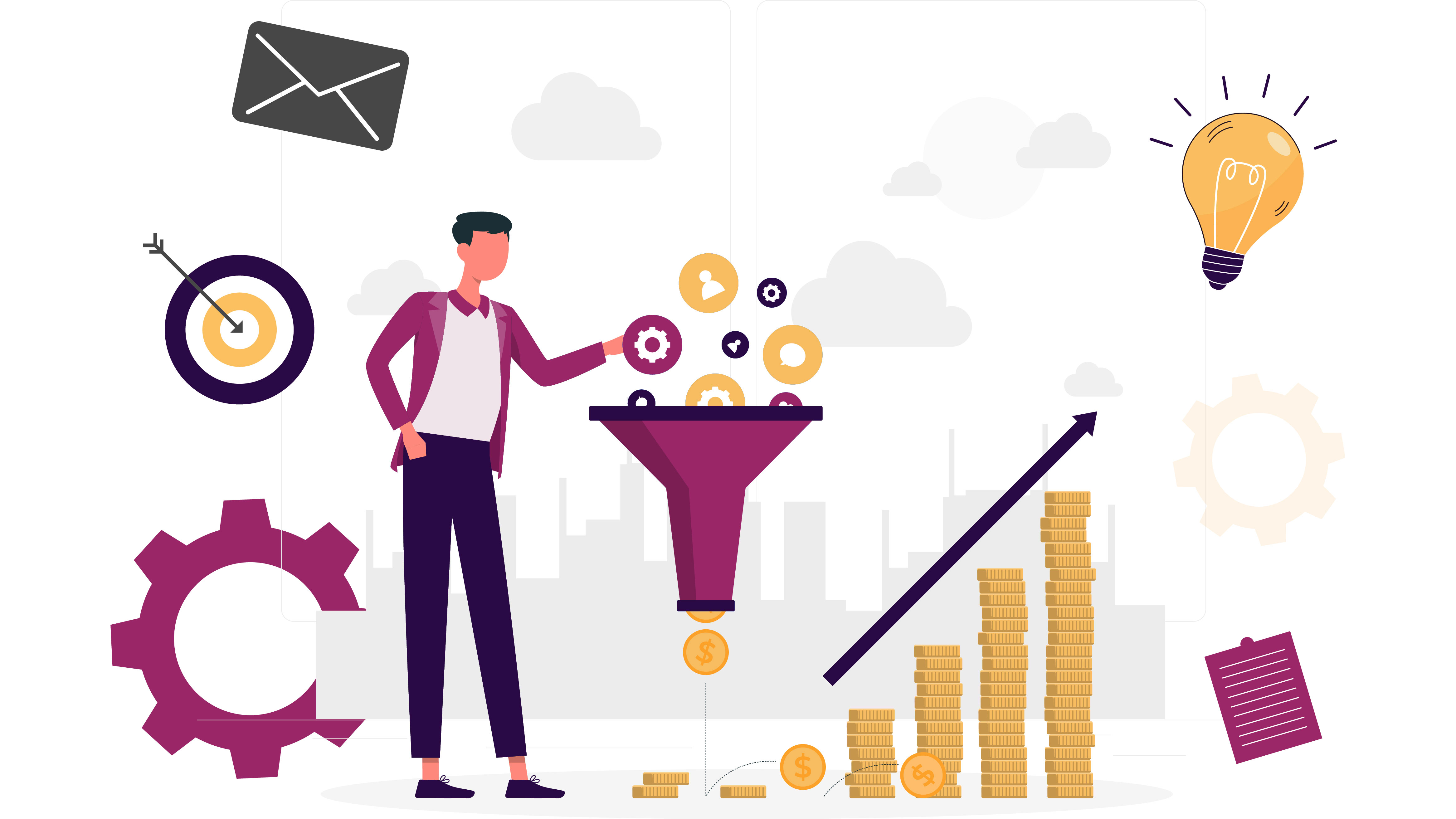
Top 12 Lead Conversion Rate Optimization Tips for B2B Businesses
Are you tired of putting in endless efforts to drive traffic to your B2B website only to see minimal conversions?
Think about it: For every $92 companies spend on acquiring leads, only a measly $1 is invested in converting them.
Shockingly, only a mere 22% of marketers are satisfied with their conversion rates.
Marketers often find themselves dissatisfied because they are unaware that the average rate is around 3.7%.
This is why you must first understand your lead conversion rate. For that, you need to grasp your marketing funnel and the sales pipeline clearly. It’ll help you calculate your lead conversion rate, i.e., the precise number of leads required to win over a new customer.
Your lead conversion rate helps you outline and quantify your marketing objectives. In addition, it shapes the trajectory of your lead pipeline.
So, today, let's break down what lead conversion rate entails, explore methods to establish meaningful benchmarks, and uncover strategies for elevating your metrics over time.
What Is Lead Conversion Rate?
Lead conversion rate is a yardstick to gauge how effectively your business transforms potential leads into actual customers. It tells you the percentage of leads that successfully take the desired action, whether it's any of the following:
- Making a purchase
- Signing up for service
- Becoming a paying client
Lead Conversion Rate Formula
Here's the formula:
Lead Conversion Rate = (Number of leads turned into customers) / (Total number of leads generated) x 100
For instance, if your company gathers 800 leads in a specific timeframe and 80 of them become customers, the lead conversion rate would be:
Lead Conversion Rate = (80 / 800) x 100 = 10%
The above is a straightforward formula. However, if you go more in-depth, the lead conversion rate can also be the percentage of how many potential customers turn into:
- Sales opportunities
OR - Actual purchases
To illustrate this in further detail, Ibad Hussain, Head of Marketing at Embedwiz, gives a practical example:
“Let's say there's a company that makes a tool to help with managing projects:
They get 100 potential customers interested through different ways like marketing. Out of these, 30 are genuinely interested and like the product.
From those 30, the sales team is able to turn 25 into sales opportunities. That's an 83% conversion rate (25 out of 30). It's because they are really good at picking the right customers and working together between marketing and sales.
However, out of those 25 sales opportunities, only 5 end up actually buying the product. That's a 20% (5 out of 25) conversion rate.
This can happen because the product might not be a perfect fit for everyone, the price might not be just right, or there might be other similar products they can choose from.”
Significance of Your Lead Conversion Rate
Grasping your lead conversion rate's significance is pivotal. It shapes your approach to budgeting for lead acquisition.
If you market a lower-priced product (e.g., $30/month) and maintain a 7% conversion rate, your budgeting aligns with this reality.
Moreover, this comprehension fine-tunes your financial projections.
Constructing a model necessitates predicting customer growth. Armed with monthly lead figures and conversion percentages, you can craft an accurate financial forecast.
Now that you know the basics, let’s check out some expert tips to optimize your lead conversion rate.
Lead Conversion Rate Optimization: 12 Practical Tactics
Suppose your computed lead conversion rate appears unexpectedly high. In this case, you can quickly improve your number using the correct lead conversion rate optimization practices.
In addition, you can achieve double-digit conversions by implementing effective lead conversion rate optimization strategies. Let’s start with our techniques:
1. Segment Your Audience
Your audience is a distinct set of individuals. Consider dividing them into segments for tailored communications to foster their continuous engagement.
Again, integrating personalization into ad communication proves extremely potent for enhancing lead conversion rates.
The key to achieving this personalization is accurately segmenting your audience according to their personas and engagement patterns. Here’s an example:
| Segment: Corporate Decision-Makers |
| Description: High-ranking professionals responsible for financial decisions in large corporations |
| Persona Traits: Strategic, numbers-driven, focused on ROI |
| Engagement Pattern: Attends financial webinars, subscribes to industry newsletters |
| Segment Goal: Offer tailored solutions for optimizing corporate finances |
| Messaging Approach: Highlight ROI potential, stress strategic benefits |
| Personalized Content: Webinar invites on advanced financial strategies |
| Platform: LinkedIn for professional engagement |
| Remarketing Strategy: Showcase success stories of similar corporations |
| Expected Outcome: Higher engagement, increased interest in specialized services |
Leveraging Google Analytics aids in tracking audience engagement tiers and facilitates the creation of audience segments. With these segments in place, the next step involves directing finely personalized ads toward them.
This feat is achievable through strategies like Google Ads remarketing or on the Facebook platform.
2. Personalize Cold Emails
When you're dealing with cold emails, NEVER hurry the process. Instead, take the time to craft each message thoughtfully – tailoring it to align with the recipient's specific preferences and pain points.
This attention to detail is what sets apart a generic, mass-sent email from one that genuinely resonates.
Imagine receiving an email that was designed just for you. It acknowledges your industry, understands your challenges, and offers a potential solution.
That kind of personal touch leads to higher engagement and better chances of conversion.
You're reaching out to potential clients in the IT sector. Give a nod to a recent industry trend that's shaking things up. This small gesture shows you've tried to understand their world.
The effectiveness of this approach is further corroborated by Jon Morgan, CEO of Venture Smarter, who says:
“Consider this fact: personalized emails have a 26% higher open rate. Making content that fits leads not only gets their attention but also builds trust. Imagine guiding leads through a journey that addresses their issues and shows how your solution helps. It's like creating a story where they're the main character, and your product is their solution.
Speed matters too. Research shows responding to leads within 5 minutes makes them 900% more likely to convert. Quick engagement shows commitment and sets the tone for an active relationship.”
3. Embrace Warm Calling
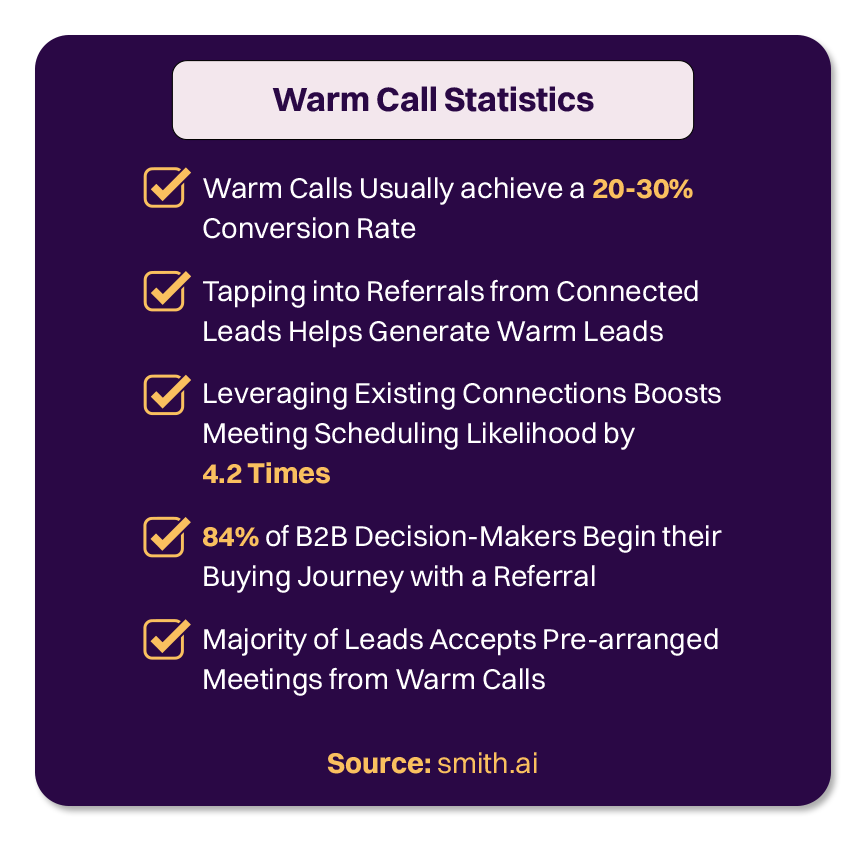
Here's a scenario: Think about answering a call from someone who not only knows your name but also understands your business needs. That's the power of warm calling.
So, instead of diving into cold calls blindly, take a warmer approach. Prioritize leads who have shown interest or engaged with your content.
For instance, if someone downloaded your recent e-book on effective financial planning, that's a warm lead right there. When you call, reference the e-book and how it aligns with their financial goals.
Such thoughtful connections can turn a hesitant conversation into a valuable discussion.
4. Focus on Continuous Prospecting
When you prioritize continuous prospecting, you continue to identify and engage potential leads. This diligent approach can significantly boost your lead conversion optimization rates. Here's how:
- Consistent Lead Flow: Continuous prospecting ensures a steady stream of fresh leads entering your pipeline. This consistency prevents gaps and keeps your sales team actively engaged.
- Early Engagement: By reaching out to prospects early in their decision-making journey, you establish your brand as a resource from the start. This early engagement can build trust and familiarity.
- Tailored Approach: Regular prospecting allows you to fine-tune your approach based on real-time feedback. You can adjust your messaging and strategies to resonate better with your audience.
- Responsive Outreach: With continuous prospecting, you can quickly respond to market shifts, adapting your tactics to match changing needs and trends.
- Conversion Momentum: Consistent outreach keeps your brand top-of-mind. As prospects move through the decision-making process, your persistent presence can tip the scales in your favor during the critical conversion moment.
- Data-Driven Refinement: Regular prospecting generates valuable data on what works and what doesn't. This data can be analyzed to refine your strategies for better lead conversion rates over time.
5. Prioritize Lead Nurturing
On average, it requires seven touchpoints before a prospect considers purchasing your product or service.
This guideline, often called the "marketing rule of 7," is a foundational principle for shaping sales and marketing strategies. It helps you gauge the necessary frequency of interactions with a lead.
Consequently, this emphasizes the importance of nurturing your leads progressively. It entails providing them with:
- Valuable content
- Showcasing product offers
- Offering informative demo videos
–and more.
Tarun Agarwal, VP of Growth, Mailmodo, sheds light on how to use emails to nurture your leads:
"Converting interested individuals into satisfied customers requires a good nurturing sequence on emails. It involves sending helpful emails, sharing success stories of your product, and highlighting what makes your product special.
Your emails should strike a warm and informative tone. Find the right balance in email frequency. Remember, the goal is more than just numbers; it's about guiding potential customers on a journey they'll appreciate.
As the saying goes, 'Effective nurturing paves the way for customer growth.' So, blend the essence of your product with relatable stories, and witness your leads transform into loyal customers."
NOTE: Keep in mind that, depending on the price point of your product, a bit of strategic sales effort might also be necessary to guide the lead toward the final decision.
6. Align Sales and Marketing
The commonly seen disconnect between sales and marketing teams can lead to missed opportunities. While marketing efforts may lack follow-up, sales teams can feel unsupported. To drive conversions, it's crucial to bring these teams together.
- Aligning Goals: Both teams should support each other's objectives, whether targeting specific markets or generating qualified leads. Hold regular check-ins to maintain alignment and ensure both teams are on the same page.
- Elevate Lead Quality Standards: Establish a shared understanding of what constitutes MQLs (Marketing Qualified Leads) and SQLs (Sales Qualified Leads). If conversions are a challenge, consider reevaluating these definitions and setting higher standards for lead quality.
By allowing marketing to nurture leads for more extended periods, they become more qualified, increasing the likelihood of conversion when they reach the sales team.
- Empowering the Sales Team: Marketing should be vested in seeing the leads they generate become sales opportunities and contribute to revenue.
To optimize conversions, the marketing team must support the sales team by informing them about their initiatives. Marketers should also provide the necessary tools – additional resources and tailored messaging – to help SDRs (Sales Development Representatives) close deals successfully.
7. Write Targeted Copy with Exciting CTAs
Craft your message with precision and excitement by writing targeted copy and compelling Calls to Action (CTAs).
Here's the idea: When you're creating content, whether it's an email, a blog post, or a social media update, make sure the language speaks directly to your intended audience. Understand their needs, pain points, and aspirations.
This tailored approach grabs their attention and makes them feel you're addressing their concerns.
Now, the CTA is your secret weapon. It's the part that tells your audience what you want them to do next.
Instead of the usual "Click Here" or "Learn More," inject a dose of excitement.
Think "Unlock Exclusive Insights," "Start Your Journey Now," or "Get Ready to Transform."
These exciting CTAs create a sense of urgency and curiosity, driving your audience to take that desired action. Here’s an example of such a CTA from ClickUp:
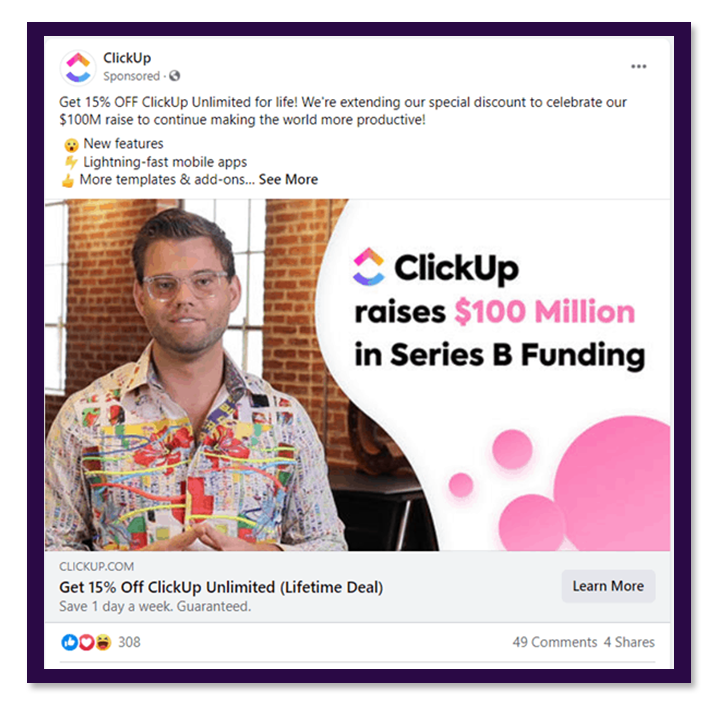
8. Remove Frictions from the Sales Funnel
Frictions are any barriers that hinder the smooth progression of a potential customer through the buying journey. By identifying and eliminating these obstacles, you create a seamless experience that encourages leads to transition smoothly from one stage to the next.
When frictions are removed, you get:
- Smoother Flow: Leads encounter fewer obstacles, making it easier for them to navigate through the sales process.
- Reduced Abandonment: With fewer hurdles, leads are less likely to abandon their journey due to frustration or confusion.
- Faster Decision-Making: Streamlining the process means quicker decision-making, preventing leads from losing interest along the way.
- Enhanced Trust: A frictionless experience builds trust, as leads feel your business prioritizes their needs and values their time.
- Increased Conversions: By simplifying the journey and minimizing barriers, you create an environment where more leads convert into customers.
For instance, simplify the sign-up process, minimize form fields, provide precise navigation, offer instant customer support, and ensure a mobile-friendly experience.
9. Design Automated Campaigns
Create a series of pre-planned, scheduled communications that engage leads and guide them through their journey. This automated, strategic approach has several benefits for optimizing sales lead conversion rates:
- Consistent Engagement: Automated campaigns maintain a steady flow of interactions with your leads, keeping your brand top-of-mind.
- Timely Follow-ups: Automated responses ensure timely follow-ups after initial interactions, preventing leads from slipping through the cracks.
- Personalized Communication: These campaigns can be tailored based on lead behavior and preferences, delivering relevant content and offers.
- Efficient Nurturing: By gradually delivering valuable information and resources, you nurture leads efficiently without constant manual effort.
- Lead Qualification: Automated campaigns can include lead-scoring mechanisms, helping prioritize high-potential leads for more personalized attention.
- Scalability: As your lead base grows, automation ensures that each lead receives consistent, thoughtful communication without overwhelming your team.
For example, imagine a lead subscribes to your newsletter. An automated campaign could trigger a series of emails introducing them to various aspects of your product or service, culminating in a tailored offer based on their interactions.
10. Embrace Real-Time Messaging
Like live chats, real-time messaging has a global average response time of 39 seconds. Therefore, it’s no wonder why 72% of buyers are satisfied with live chatting!
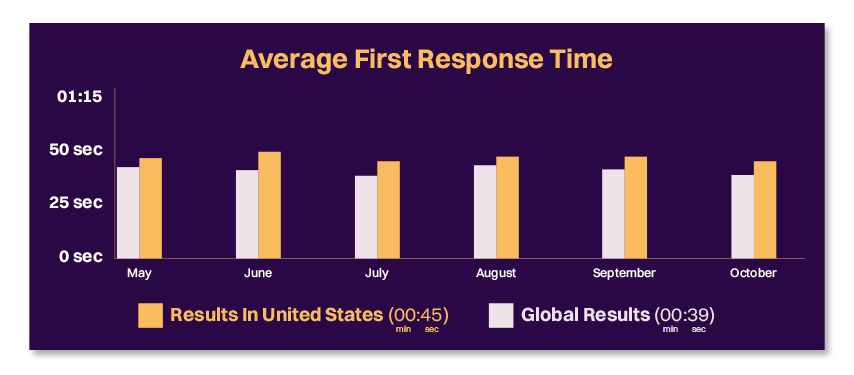
With Live Chat, you can offer immediate support and guidance to your website visitors.
To optimize conversions, integrate messaging features into your top-performing web pages, such as pricing and product pages. This way, leads can obtain the information they need promptly.
For instance, if a visitor spends more than a minute on a specific page, you can automatically offer assistance and address any inquiries they may have.
11. Monitor Your Content Performance
You post content regularly - right? But you should also keep track of how your posts perform. It’s extremely important to know the metrics – to increase leads from content. Here’s how:
- Insightful Analysis: Monitor critical numbers like views, engagement, and conversions. These metrics will give you valuable insights into which areas of your content are working. You can also gauge gap areas for improvement and remove resources pulling you down.
- Refined Strategy: Analyzing content performance helps you refine your content strategy. You can focus on creating more of what resonates and adjust or eliminate content that underperforms.
- Audience Understanding: Monitoring content interactions provides a deeper understanding of your audience's preferences, allowing you to tailor future content to their needs.
- Conversion Insights: Tracking content-to-conversion paths reveals which content is most effective at guiding leads toward conversion.
- Optimized Lead Nurturing: By identifying content that moves leads closer to conversion, you can create more targeted lead nurturing campaigns.
- Iterative Improvement: Continuous monitoring enables you to make data-driven improvements over time, boosting the overall effectiveness of your content strategy.
For example, you notice that a particular blog post consistently generates higher engagement and leads to more conversions. You can take this insight and create more content around similar topics or formats, increasing your chances of conversion.
12. Follow the PIE Framework
Before diving into a lead conversation rate optimization project, prioritize your efforts by evaluating each element based on its:
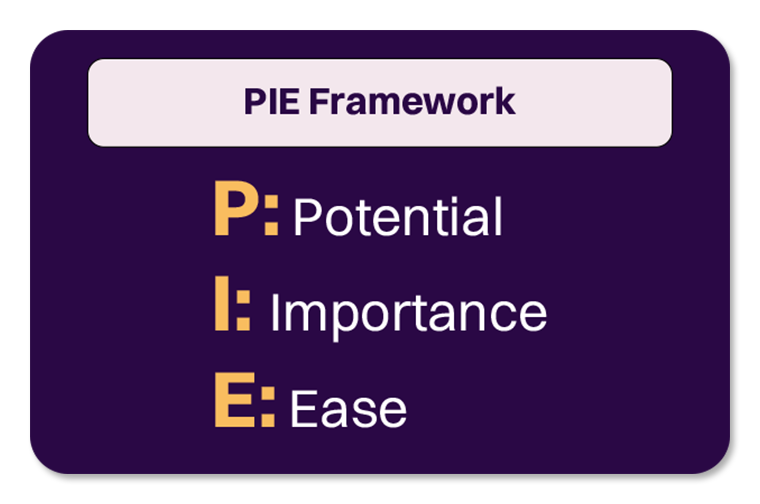
By utilizing the PIE framework, you can assess every strategy outlined in the previous section by considering the following questions:
- How much improvement can this project bring?
- How valuable is this improvement?
- How complex or challenging will it be to implement?
Steps to implement the PIE model:
- For each strategy, assign a score ranging from one to ten, with one being the lowest and ten being the highest.
- Once you have scored each strategy, calculate the total by summing up the scores and dividing it by three. This resulting score will indicate the project's overall impact.
- Start by working on projects with the highest scores first, as they will likely significantly influence your efforts.
While the PIE framework may not be flawless, it offers a straightforward and systematic approach. It is a starting point for collaboration and communication among colleagues engaged in optimization activities.
Pro Tip
Well, this surmises our tips for optimizing your conversion rates. However, remember that you should not live and die purely by the numbers.
As explained by Ryan Mckenzie, the Co-Founder & CMO of Tru Earth:
“Conversion rates are one metric, but successful businesses look into the quality of those conversions and the lifetime value of those converted customers. This depth of understanding can ensure that you're attaining high-value customers, not just high numbers.
Conversion isn't about tricking potential customers into a sale; it's about providing genuine value and cultivating trust. When your business stands as a solution to their needs, the conversion naturally follows.”
The Way Forward
Now is the perfect moment to take action and improve your lead conversion rate by applying these 12 valuable tips. Regardless of your organization's size or industry, there are always innovative approaches to explore and experiment with to boost your conversion rate.
However, gaining insights into practical tactics and avoiding pitfalls becomes much simpler when you join forces with Revnew. As a trusted partner, Revnew can provide expert guidance and tailor-made solutions to optimize your conversion strategies.
Don't settle for stagnant results. Connect with Revnew today and unlock the potential for remarkable conversion rate improvements.
